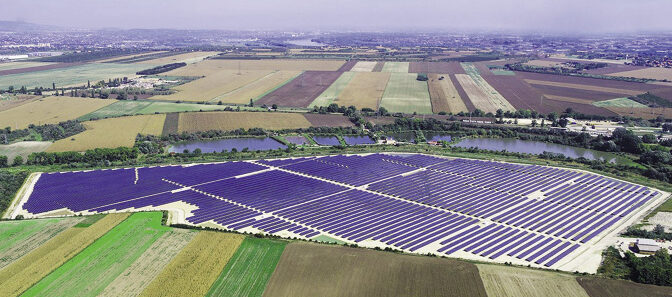Solar momentum is building in Hungary with almost 4 GW of generation capacity, more than 2.5 GW of which is from arrays bigger than 50 kW in scale, according to data published in December by the Hungarian Energetic and Public Utilities Regulatory Authority.

Image: Astrasun Solar
A nation with only 26 MW of solar in 2016 added more than a gigawatt last year and the 2030 National Energy Strategy target of having 6 GW of solar may be reached within five years.
These figures demonstrate significant demand for clean, affordable solar energy but the rapid expansion of PV has outpaced the ability of an under-developed national grid to keep up, with ramifications for regulation, a slowing in energy investment and even falls in the value of the forint.
The Hungarian operation of German energy company E.ON in January announced plans for a €190 million ($201 million) investment into its grid network, partly financed by the EU, to open up 700 MW of grid capacity by 2026. State-owned peer MVM Group and Swiss-owned gas company Opus Titász have announced HUF 96.6 billion ($258 million) of grid investment plans.
Despite those developments, contradictory policy and regulation clouds the outlook for Hungarian solar.
In April 2021, the lack of network capacity prompted a ban on licences for solar plants above 50 kW in scale. Below that size, grid-connected household self-consumption arrays were permitted and industrial arrays can still be approved, albeit for self-consumption only and often requiring energy storage.
Solar ban
In May, national transmission system operator (TSO) Magyar Villamosenergia-Ipari Atviteli Rendszeriranyito (Mavir) announced there is no free grid capacity to back tenders. That means new solar plants can only be permitted via a “unique procedure,” under which the TSO issues specific conditions for eligibility, usually requiring developers to fund any necessary grid infrastructure. Even then, eligible projects must fulfill “exemption conditions” which lack transparency.
In October, the Hungarian government introduced a provision for small, household-sized solar power plants that fundamentally transformed the Hungarian solar market. Since Oct. 31, the aforementioned, sub-50 kW, grid-connected household systems could no longer have a grid connection and could only be used for self-consumption.
That effectively means such systems will only have value if paired with energy storage. The inevitable impact on the market prompted the Ministry of Energy to state, in early February, that it will review the “small-scale solar panel stop” measure.
EU gridlock
Hungary, of course, is not the only nation to experience grid capacity shortages caused by the rapid emergence of renewable energy generation – similar problems have occurred in Germany and Romania – the unpredictable, at times ad hoc nature of Hungarian energy regulation indicates the market is under intense scrutiny in Budapest.
The EU could play a significant part in helping prepare the Hungarian grid for more renewables capacity by resolving its dispute with Viktor Orbán’s government and releasing the funds approved for allocation to the country under the bloc’s Covid recovery fund.
The devastating effects of climate change on the environment, as well as the economic and geopolitical events of recent years, have demonstrated that green energy is clearly the path to a sustainable future. More particularly, they have illustrated that, in the long run, only a diversified energy mix can provide national energy security.
Popular content
The government has moved to address this with pro-solar and energy-efficiency subsidies. In September, the second phase of an EU-financed HUF 201 billion solar and heating modernization fund was launched. Under the program, families with less than the national average income can claim a non-repayable grant of up to HUF 2.9 million to install solar, plus up to HUF 11.3 million to add a heat pump, energy storage, and replace windows and doors. The fund was intended to cover all such costs but high inflation has meant the grant does not reach 100% of costs, even if it remains popular.
A separate home renovation grant offers families with, or expecting, a child up to HUF 3 million to cover half the cost of works and can include solar expenses provided they are no more than HUF 450,000 per kilowatt of generation capacity installed.
In addition, members of the Hungarian cabinet have indicated a willingness to back solar plants up to 800 MW in scale.
Manufacturing
To supercharge Hungarian solar, in addition to network investment and clearer regulation, the nation needs local manufacturing. My company, Astrasun Solar, has signed an agreement with Hungarian conglomerate Műszertechnika-Holding and its vehicle-chassis manufacturing operation IK Metál to produce solar mounting structures.
While the European Union’s REPowerEU initiative, unveiled in May, aims to wean the bloc off Russian gas with the help of a solar energy strategy, the plan fails to address the market’s dependence on solar imports from China.
As the strategy stipulates, the EU primarily aims to increase its 35 GW of annual solar panel module assembly capacity. Insufficient attention has been paid to the fact Europe has only a gigawatt of solar ingot and wafer production lines – the basis of solar panel manufacturing. The China Photovoltaic Industry Association has estimated the country boasted more than 98% of global ingot and wafer manufacture in 2021.
State support
The EU strategy should be aiming for at least a 20% to 40% expansion in European silicon production and ingot manufacturing capacity. With those operations exceedingly energy intensive, there would be a need for long-term, low-price, fixed state support for the electricity supply to manufacturers. These details should have been worked out long ago.
There is room for development in solar strategy in both Hungary and Europe and progress could be unlocked by social and professional dialogue to resolve contradictions and strengthen vulnerable points of the market.
More stable, predictable solar policy could open the way for a perfectly-located Hungarian PV market and for its companies to play a leading role on the European scene.
About the author: Dr. Attila Keresztes is founder and CEO of Astrasun Solar Plc, a Hungarian solar power plant design, construction, operation and maintenance, investment, and development company. Attila has more than 10 years’ experience in solar.
The views and opinions expressed in this article are the author’s own, and do not necessarily reflect those held by pv magazine.
This content is protected by copyright and may not be reused. If you want to cooperate with us and would like to reuse some of our content, please contact: editors@pv-magazine.com.


2 comments
By submitting this form you agree to pv magazine using your data for the purposes of publishing your comment.
Your personal data will only be disclosed or otherwise transmitted to third parties for the purposes of spam filtering or if this is necessary for technical maintenance of the website. Any other transfer to third parties will not take place unless this is justified on the basis of applicable data protection regulations or if pv magazine is legally obliged to do so.
You may revoke this consent at any time with effect for the future, in which case your personal data will be deleted immediately. Otherwise, your data will be deleted if pv magazine has processed your request or the purpose of data storage is fulfilled.
Further information on data privacy can be found in our Data Protection Policy.